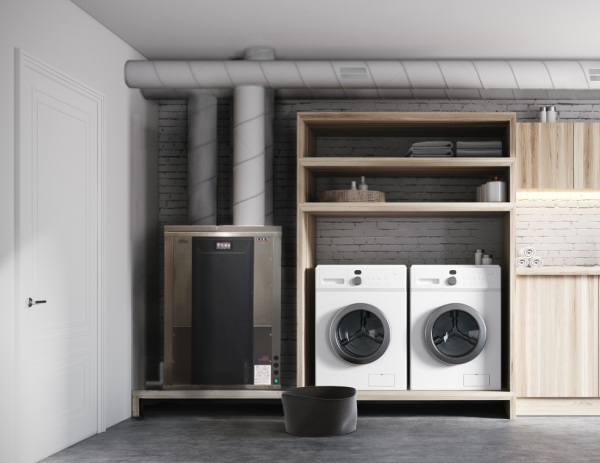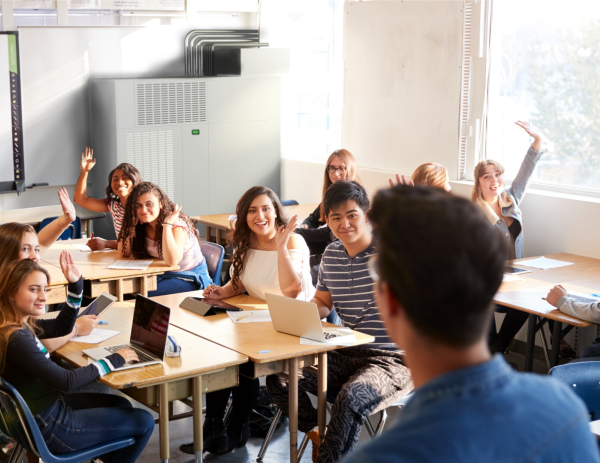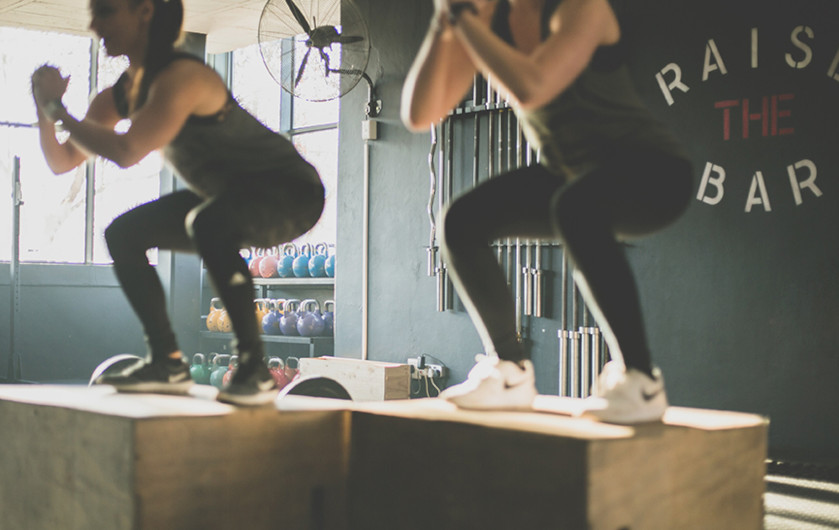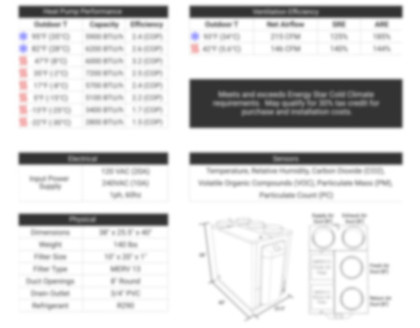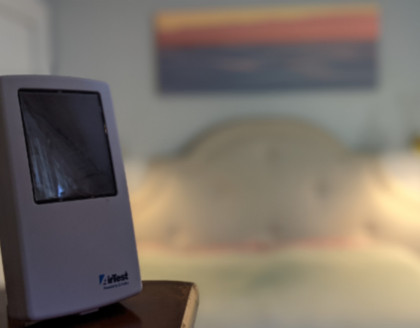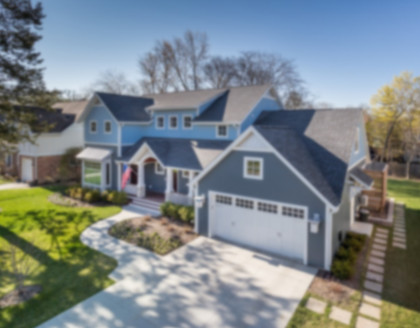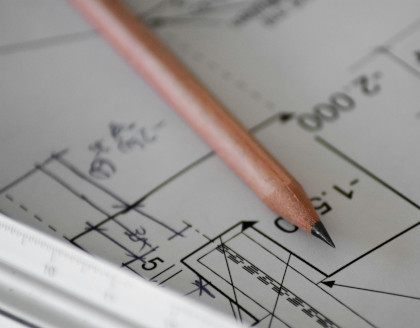Exercise is important! Elevated metabolism gets blood flowing to the extremities of our body and our brain, cleansing and revitalizing us. And, it is important to exercise in a healthy environment. Similar to bicycling in a polluted city, the health benefits of exercising in a room with poor air quality may be worse than not exercising.
Fresh air ventilation rates must be increased to meet increased respiration as exercise elevates metabolism and carbon dioxide generation. Ty’s chamber test article demonstrated that exercise increased his carbon dioxide generation by four to five times relative to sitting calmly.
The plot below shows carbon dioxide data from four, once-per-week exercise classes with differing number of class participants. The classes were held in the same room with the same exercise program, lasting one hour. Carbon dioxide concentration increased throughout each class, indicating constant rather than smart ventilation.
Volatile organic compound (VOC) data from the exercise classes are shown in the second plot. VOCs are created by a variety of processes that do not correlate as strongly as carbon dioxide does with occupancy. Unlike carbon dioxide which is a direct result of respiration (assuming no combustion processes like gas cooking), VOCs are exhaled in our breath, exuded from our bodies with perspiration, and released from chemicals absorbed in our clothing (eg, third-hand smoke and other odors picked up from places we have visited). VOCs are always changing and transforming; some VOCs degrade into water and carbon dioxide, and others turn into other substances (eg, underarm body odor).


We can tell a lot about a room based on carbon dioxide levels. First, we can tell that the fresh air flow rate to the exercise room is about 800cfm. Second, we can see that as class attendance increases, the fresh air per class attendee drops while the peak level of carbon dioxide increases. The plot below shows both of these trends.
Human activity is quantified as “Mets”, or metabolic units. Sleeping is 0.7 Mets while vigorous, unsustainable physical exertion is 7 Mets. Quietly sitting is 1 Met, while office work (“sedentary”) activity is 1.2 to 1.5 Mets. Kitchen and housework are 2 to 3 Mets, while vigorous, sustainable activity such as an exercise class is 4 to 5 Mets. The most important aspect of Met level is that our fresh air ventilation needs change in proportion to metabolic units because higher energy activity burns calories, and burned calories produce carbon dioxide. From sleeping to energetic activity, our fresh air ventilation needs vary by a factor of 10!
Unfortunately, current building standards (ASHRAE 62.1 for exercise and fitness facilities) go in the opposite direction of our needs, reducing fresh air per room occupant as occupancy increases with no adjustment for metabolic activity! For this 3000ft2 fitness facility an occupancy of 30 persons, ASHRAE 62.1 requires 780cfm (20cfm per person plus 0.06cfm/ft2 floor area). From our data analysis, the facility meets ASHRAE 62.1, however, the inadequacy of today’s ventilation standards is evident with carbon dioxide concentrations exceeding 1000ppm.

Summary
Breathing unhealthy air while exercising is counterproductive to improving our health and well-being. Inadequate ventilation standards extend well beyond fitness centers. Our 2014 field study of a business with 120 employees, our study of classroom IAQ, and the horrendous state of housing for our military service personnel show how widespread poor air quality is in our building environments. Poor air quality is much more expensive than the cost to improve our indoor environment.
Poor air quality also increases transmission of airborne disease. As we discussed more than two years ago at the beginning of the pandemic, improved fresh air ventilation and air filtration reduces disease transmission and decreases the ability of a disease to self-sustain its transmission. While many have been surprised at the impact of the pandemic, we’ve been expecting it for some time (see slide 38 from a NESEA presentation 6 years ago). The transition of Covid to seasonal epidemics does not mean we can relax. This is the time to improve our buildings to prepare for the next pandemic.
The good news is that we don’t have to guess how much ventilation and filtration are needed to reduce the probability of getting sick. Our Covid Safe Space calculator, based on the well-known “Wells-Riley” airborne disease transmission model, tells us directly. For a fitness facility such as this one, the calculator tells us that a room with 30 people at 5 Mets activity with 2400ppm carbon dioxide concentration has a fresh air ventilation rate of 808cfm. If one person is infectious with influenza or the original Covid strain with similar transmission characteristics as the flu, the calculator tells us we have 14% chance of becoming infected after 1 hour of exposure. The calculator also tells us that four people in the class will become infected from a single infectious person, indicating that the fitness class is multiplying the disease.
If the exercise room maintained carbon dioxide at 800ppm, the probability of becoming infected drops below 3%. Also, less than 1 person out of a class of 30 may become infected which means the disease is no longer replicating at a sustainable rate. The Covid Safe Space calculator tells us we need 4000cfm of fresh air ventilation, for a ventilation level of 135cfm per person. Many “experienced” ventilation engineers and efficiency experts will strongly react to such a high ventilation rate, citing high energy costs, especially at a time when we’re working to reduce energy consumption.
How much will healthy ventilation cost? For Illinois with challenging winter and summer weather, energy cost will be $0.03/hour-person in January, $0.002/hour-person for sensible summer cooling, and $0.06/hour-person for latent (dehumidification) conditioning. These numbers assume today’s renewable energy costs (12 cents per kWh) for no negative impact on global warming, but a big positive impact on employment and business activity.
Capital required for installing an efficient heat pump comfort conditioning and energy recovery ventilation system will be $25 per cfm for a total cost of $100,000. Although this capital expenditure is large for a small business, assuming 10 years of equipment life and two fitness classes per day with 30 participants, the capital cost per class attendee is 46cents. Which would you choose? A fitness class that has healthy indoor air and cost 50cents more per class, or the less expensive option that degrades your health and makes you sick?
The cost to create healthy indoor environments is worth it. We need smart CERV2-like systems that automatically keeps homes healthy, in all buildings. Stay tuned to learn exciting news about Build Equinox efforts to move our smart IAQ technologies beyond our homes!

